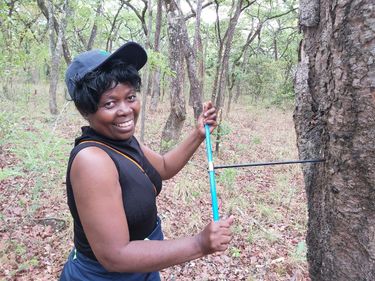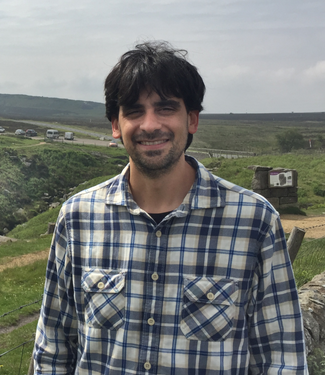
Sessions in which Jorge A. Giraldo participates
Thursday 30 June, 2022
The occurrence of annual growth rings in tropical trees—the result of the seasonal activity of vascular cambium—has been explained either by seasonal periods of water deficit or flooding. However, little is known about the drivers of annual tree-ring formation under tropical hyper-humid conditions without evident seasonal dry periods or flooding (ever-wet conditions). Shelford's law states that both the deficit and the excess of environmental resources limit plant growth. Accordingly, we h...
Dendrochronological archives in the tropics of the Americas have been under-studied for a long time. Some of the challenges include the Identification of tree-ring boundaries in certain tree species, absence of winter dormancy associated to low temperatures in most of the cases, and logistic difficulties of fieldwork in remote sites. However, part of the slow progress is also related to the fact that historically much less resources have been inv...
Sessions in which Jorge A. Giraldo attends
Monday 27 June, 2022
MAIDENiso is a numerical process-based model that allows researchers to simulate the growth of a virtual tree. Using daily meteorological data, the model simulates the physical and physiological processes taking place in the tree and its environment, to produce daily and yearly outputs comparable to dendrological observations. The model has been adapted and used successfully in boreal regions in North America. In an inverse mode, tree-ring obs...
Free, in person and onlineThe stable isotopic compositions of carbon and oxygen (d13C and d18O) measured in tree rings are valuable proxies for reconstructing paleoclimate and are increasingly used as paleophysiological proxies. Applying these proxies in ecophysiology and paleoclimate can be challenging as they rely on complex process-based models and poorly constrained input data. In recent years, h...
Tuesday 28 June, 2022
Africa is faced with a number of challenges including climate change and ecological disturbance due to various anthropogenic activities. These problems adversely affect the forests and also ecosystem services. My appreciation for the forests motivated me to pursure my undergraduate studies in Forestry. I first applied dendrochronology during my PhD research which focused on understanding the climate change vulnerability of the Zambezi teak forests in Zambia. However, lack of research facil...
Maritime forests are extremely important for coastal protection as they buffer storm surge and wind, conserve nutrients, and store groundwater. They grow several 100 meters behind primary beach dunes or along intertidal marsh-forest ecotones and within range of salt spray, near shoreline estuaries, where they support large amounts of biodiversity and migratory birds. Trees in these forests typically handle small concentrations of salt spray, strong winds, and slight flooding, but prolonged...
Tree-ring research studies depend heavily on samples, but the connection to the sampling theory remains loose. Tree-ring studies need to be based on samples of restrained size for several reasons: measuring tree-ring features remains labour-intensive, costly, and sampling cannot be seen as totally free of consequences for trees. Sampling, the art of selecting observational units to produce population-level estimates, comes with constraints that, when not respected, lead to biases and loss ...
Although numerous proxy-based climate reconstructions have been developed and despite the prevalence of relatively long instrumental records throughout Europe, reliable information about past climate is still lacking in some regions, particularly eastern parts of the continent. This issue is linked to limitations in data quality and large uncertainties in existing records. The REPLICATE project aims to fill this spatial paleoclimatic and data quality gap by applying a tree-ring multi-param...
Forest responses to climate change are highly uncertain, but critical for forecasting and managing forest carbon dynamics. Tree-ring time series data provide annually resolved growth responses to climate, but often lack the stand-level information needed to scale growth up to carbon uptake. In contrast, the U. S. Forest Service Forest Inventory and Analysis (FIA) Program is an exceptional spatial network to estimate forest carbon, but lacks the annual resolution needed to determine how tre...
We present a 211-year tree-ring-based reconstruction of the annual mean flow of the Sainte Anne River, Gaspésie, Québec, Canada. The river traverses through the interior of the Gaspé Peninsula where the instrumental hydrological and climatic records are particularly short. This is the first streamflow/soil moisture reconstruction between the Hudson River and north-central Québec, filling a substantial geographical gap along the eastern North American margin, and adding to the only three ex...
Past forest mortality after disturbances creates one source of uncertainty that needs to be taken into account to reconstruct biomass dynamics. Additionally, using unitless normalized data from tree-ring records to calibrate stand productivity in vegetation models constitutes another source of uncertainty for model calibration. In this presentation I would assess these two sources of uncertainty and discuss the influence of calibration technique in model-data fusion. I combined data from p...
Forest disturbances and tree growth are major drivers of dynamics and long-term carbon storage in forests. Combining forest inventory data and tree-ring analysis allows for a retrospective estimate of aboveground forest biomass (AGB) and disturbance dynamics at decadal to centennial scales, both being directly related to net primary productivity (NPP). We used this combined approach to estimate precisely-dated ages of aboveground carbon in over 20 temperate old-growth forests in Western Eu...
Tree-ring time series provide long-term, annually resolved information on the growth of individual trees. When sampled in a systematic context, tree-ring data can be scaled to estimate the forest carbon capture and storage of landscapes, biomes, and ultimately the globe. A systematic effort to sample tree rings in national forest inventories would yield unprecedented temporal and spatial resolution of forest carbon dynamics, and help resolve key scientific uncertainties, which we highlight...
Tree-ring time series provide long-term, annually resolved information on the growth of individual trees. However, public tree-ring archives contain a considerable portion of data collected from trees that have been selected with specific research questions in mind (e.g., for climate reconstruction). This makes these archives a biased representation of the sensitivity of forest ecosystems to ongoing climate variation (e.g. temperature, precipitation), including non-stationarity (i.e....
Mexico has a forest cover of 660,400 km2, representing 34% of its territory. Due to deforestation and land-use change, Mexico has lost 32,200 km2 over the last 25 years, representing 1.9% of its territory. Mexican forests are now additionally threatened by climate change. Currently, there is no assessment of the impact of current and future climatic changes on forest productivity to develop mitigation and adaptation plans in the forestry sector. Most growth studies in Mexico focus on clima...
Ultra high resolution imaging is becoming standard across the sciences and must be a priority for dendrochronology. Large format scanners fail to resolve micro rings and the anatomical structures of increasing scientific interest. Meanwhile, current software limitations include cost, user experience, data management flexibility, and capacity for handling large file sizes. We argue for a new paradigm and present a technology framework that integrates gigapixel macro photography, a cloud-hos...
Tree-ring research has given generations of scientists a long memory of what is acceptable for a tree to be included for data analysis. The established criteria, however, were set through purposeful goals to maximize the response for climatic reconstructions. Ecology is different. Tree-rings are increasingly being used to study a wide swath of ecology, including the carbon cycle or the response of ecosystems to global changes. A fundamental aspect of ecology is to understand the range of r...
Dendroclimatic reconstructions play a key role in contextualizing recent climate change by improving our understanding of past climate variability. The climatically-sensitive blue intensity (BI) parameter is gaining prominence as a more accessible alternative to X-ray densitometry. Yet accurately representing low-frequency trends and high-frequency extremes using scanner-based BI remains a challenge due to color biases and resolution limitations. As part of the REPLICATE project, methodolo...
Climate extremes are driven by a combination of thermodynamical and dynamical factors. In Europe, the primary dynamical driver of summer climate extremes is the position of the jet stream over the Europe-North Atlantic (EU) region. To study long-term variability in the position of the EU jet, as well as its potential impact on past climate extremes and human systems, we have reconstructed EU jet variability over the past 800+ years (1200-2005 CE). To accomplish this, we have combined five ...
In this work we show the application of dendrochronology as an educational resource for schoolchildren and as a mean to disseminate science to society. Tree rings are popularly known in Chile due to the massive use of wood for construction, handicrafts and firewood. The visible tree rings generate a distinct, tangible and familiar curiosity in many people. “Tree-Rings as a Natural Encyclopedia of Environmental Archives” is an exhibition built as an educational project for schoolchildren, w...
Historical accounts in the Brazilian Digital Library provide independent support for most of the tree-ring reconstructed wet season rainfall extremes in the eastern Amazon during the late-18th and 19th centuries. Newspapers, government reports, and other documents describe crop failure, livestock mortality, water shortages, and ship groundings on the Amazon River during many of the tree-ring reconstructed drought extremes. Heavy rains and flooding are described during some of the wet extre...
Tree rings have long been used to monitor forest change by measuring differences in tree ring widths through time derived from a representative sample of forest trees. However, for many reasons, tree rings have only rarely been utilized to monitor urban forest change. Urban forest change monitoring has more commonly occurred with time-series of remote sensing imagery, such as yearly stacks of Landsat satellite imagery converted to some vegetation index or other proxy. Tree rings and remote...
Half of the tributaries of the Amazon River originate in the tropical Andes; however, it is difficult to assess hydroclimatic conditions due to the scarcity of long, high-quality instrumental records. Data from the Global Precipitation Climatology Project (GPCP) provides a complete record since 1979 and offers a good representation of rainfall over the tropical Andes. Longer records are needed to improve our understanding of rainfall variability and summer monsoon behavior at various scale...
Urban trees are expected to help in mitigating the negative effects of climate change on infrastructures and human well-being in cities but warming climate with longer and more intensive dry and hot periods will also affect urban tree function and survival. To better understand the resilience and resistance of urban trees in the face of climate change, we conducted a Canada-wide collection of tree cores from cities with diverging climates (Edmonton, Montreal, Quebec City, and Halifax).&nbs...
Urban trees provide important environmental services and are indispensable for the regulation of a city's climate, whilst growing in stressful conditions with low water and space availability. However, compared to their forest counterparts, little is known about urban trees' capability to cope with climate change. Due to the heat island effect, Montreal has already experienced 1.4°C higher temperatures, creating increasingly challenging conditions for urban trees. Planting resilient trees ...
Urban trees and forests provide a variety of social and environmental benefits, but their function, and therefore the benefits they provide, can be enhanced or diminished by human influences. More work is needed to understand how urban forests mitigate, and are affected by urban heat, pollution, and other anthropogenic influences, especially in light of modern urbanization and climate change. As concentrated sites of accelerated environmental change, urban forests may also provide insight ...
Improving our understanding of the carbon cycle is key to addressing the challenges of climate change. In this study, we investigated the relationships between intra and inter-annual climate variations, carbon fluxes, and the xylem biomass in an 80-year plantation of Pinus strobus at Turkey Point, Ontario, Canada. From eddy covariance tower, we obtained daily Gross Primary Production (GPP), precipitation and air temperature for the period 2003-2018. To determine inter-and intra-annual xyle...
Urban trees provide multiple benefits such as shading and cooling, which become more and more important due to the increasing frequency and severity of heat and drought periods. It is thus necessary to identify tree species, which are able to tolerate such extreme conditions in urban areas. We studied the resistance and resilience of stem diameter growth of five deciduous tree species in an urban area in Southwest Germany to three exceptional drought periods for differences between and wit...
Dendrochronology can provide a glimpse into past periods that lack long-term ecological and environmental data. With the growing concern of climate change and the need to reach net-zero carbon, contributions of nuclear energy sources to meet net-zero goals continue to be discussed. Ontario obtains a large amount of energy from Canadian Deuterium (CANDU) reactors at the Bruce, Pickering and Darlington nuclear facilities. Conveniently, tree-rings can be used to measure radiocarbon (14C) emis...
Floods and droughts have recently worsened in the Fraser River Basin (FRB), British Columbia, causing significant impacts to western Canadian economy, ecosystems, and societal wellbeing, as well as the costliest natural disaster in the province’s history in 2021. These extreme events present a major management challenge since the FRB is susceptible to unregulated spring flood and summer drought events, even in the same year. Meanwhile observational streamflow datasets are both short and po...
Ring-width (RW) and Blue Intensity (BI) parameters (earlywood - EWB, inverted latewood – LWBinv, and delta - DB) were measured from samples of Araucaria araucana from six sites in northern Patagonia, Argentina. The distance between the most southerly and northerly sites is ca. 130 kms. Despite a much weaker between-tree signal for the BI parameters than RW, principal component analysis identifies a much stronger regional between-site signal for the BI parameters. Split period correlation r...
Chemical traits of tree-rings are sparsely used for dendroclimatic analysis. The difficulty of the laboratory process to obtain these proxies and understand their physiological relationship with meteorological variables have limited the development of dendrochemistry in tropical forests. Here, we show the first Micro X-ray fluorescence (µXRF) time series of chemical elements from Cedrela fissilis trees growing in southern Brazilian Amazon. We assess the relationships among wood traits (wid...
The impacts of inland flooding caused by tropical cyclones (TCs), including loss of life, infrastructure disruption, and alteration of natural landscapes, have increased over recent decades. While these impacts are well documented, changes in TC precipitation extremes—the proximate cause of such inland flooding—have been more difficult to detect. Here, we present a latewood tree-ring–based record of seasonal (June 1 through October 15) TC precipitation sums (ΣTCP) from the region in North ...
The representation of snow processes in forest growth models is necessary to accurately predict the hydrological cycle in boreal ecosystems and the isotopic signature of soil water extracted by trees, photosynthates and tree-ring cellulose. Yet, most process-based models do not include a snow module, consequently their simulations may be biased in cold environments. Here, we modified the MAIDENiso model to incorporate a new snow module that simulates snow accumulation, melting and sublimat...
"Little is known about the impact of volcanoes on trees from the Southern Hemisphere. In this study, we investigated whether volcanic signals could be identified in ring widths from eight dendrochronological species from New Zealand, using superposed epoch analysis. We found that most species are good recorders of volcanic dimming and that the magnitude and persistence of the post-event response can be broadly linked to plant life history traits - whether the species responds as a 'stress ...
Dendroprovenance is a discipline usually linked to dendroacheology or wood commercialization; however, other purposes as inferring the origin of wood in rivers (i.e., instream large wood, LW) are often overlooked. LW in fluvial ecosystems enhances its geomorphology and biodiversity, but also increases potential risk during floods. Thus, knowledge about its source is crucial for understanding LW dynamics and optimizing river and riparian forest management. This project aims at deve...
Drought, flooding, and hurricane activity disrupt the human and natural landscape throughout the southeastern United States. Instrumental records through the past century suggest that the patterns of these extreme events are changing through time, especially in relation to rising global temperatures. However, instrumental records before the industrial revolution are rare, thus proxy records like tree rings are useful for comparing climatological conditions before massive human modification...
Wednesday 29 June, 2022
Dendrochronology is considered one the most precise of all the scientific dating techniques. However, it requires long sequences of tree rings and a master record for both the species and region in question. At the University of Groningen, we have been pioneering a new approach to dating that combines the precision of dendrochronology with the versatility of radiocarbon dating. It relies on the detection of spikes in the annual radiocarbon record, thought to b...
Current and projected changes in climate are estimated to be from 10 to 100 times faster than the natural adaptive capacity of trees whose generation times are long. As extreme climatic events are becoming more frequent and exert a strong selection pressure on tree populations, there is an urgent need to better characterize the genetic variability involved in the response of trees to climate. There is currently a lack of knowledge on the role of genetic variability in tolerance to climatic...
Over the past 10 years, X-ray Computed Tomography (CT) has been increasingly applied to dendrochronological research. This technique provides 3D images of the internal structure of objects, allowing non-invasive access to tree rings in cultural heritage objects that are often inaccessible from the outside. Here, we will present the state-of-the-art of tomographic X-ray imaging for the application to dendrochronology. We will give a comprehensive overview of how X-ray computed tomography is...
Information garnered from historical timbers and wooden artifacts (e.g. houses, barns, ships) can greatly enhance our understanding of human, ecological, and climate history, especially in regions where few old-growth forests and trees remain, tree longevity is relatively short (less than 300-400 years), and environmental conditions break down wood rather quickly, like in mesic to wet regions. Over the last decade plus, the application of tree-ring techniques on wo...
Humans have relied on wooden timber material for the construction of buildings, trade, ships, artifacts, and works of art for many millennia. Using dendrochronological methods, it is often possible to develop to build internally cross-dated but undated ‘floating’ tree-ring chronologies using this historic wooden material. However, the dynamic nature of human mobility and long-distance transport of timber can often make it difficult to accurately date and provenance wooden material. Accurat...
In the 1970s, forest geneticists with the British Columbia Forest Service established a number of long-term provenance trials throughout the province. The Trinity Valley (TV) provenance trial was established in 1975 in the southern interior to evaluate interior Douglas-fir (Pseudotsuga menziesii var. glauca) across the species’ range. TV is a factorial experiment, where 64 populations of 4 year-old Douglas-fir seedlings were planted in a randomized complete-block design with three replicat...
Dendrochronology is a well-established science used to determine the date of wood from cultural heritage objects, and often, to infer the geographic origin of the wood withing certain regions. Dendrochronologists insists that this science provides a date and provenance for the wood, not the object. However, recent research shows that it may be possible to determine the production place of works of art based on the area supplying the wood, and on inferences about wood derived from individua...
Carbon-14 (14C) is produced via a nuclear reaction between the atmosphere and cosmic rays. Although the main source of 14C is galactic cosmic rays, solar energetic particles (SEPs) also contributes in producing 14C. Extreme SEP events are considered to produce 14C spikes that considerably exceed the 14C amount produced by galactic cosmic rays. Thus far, several signatures of 14C spikes originates by extreme SEP events have been reported, such as the 774 CE, 992 CE, and ~660 BCE events. In ...
Forty years ago Dr. Tom Yanosky, a research botanist with the US Geological Survey, reported that ash trees growing along the Potomac River contained rings with abnormal wood anatomy caused by flood damage. Dr. Yanosky recommended these rings — which he dubbed “flood rings” — could be used to estimate the date, seasonal timing, and (most importantly) peak stage of past floods. Since that discovery, flood rings have been identified for forested river systems in eastern France, central Canad...
Fluctuations in water resources is one of the main factors modulating ecosystem dynamics, human population changes and culture in semiarid regions. One of the largest high-altitude semiarid regions of South America is the Altiplano in the Central Andes. With an elevation of 4.000 m this region has been the environment for the settlement of many communities who have inhabited the region for thousands of years. Tree-ring research has been developed in this region allowing the reconstruction ...
Water scarcity is a major 21st century challenge that is increasing the vulnerability of the human population, especially in cities. Water risk assessment is a fundamental task in many cities worldwide that often lack long-term and spatially-resolved records of precipitation and level of water reservoirs. Past rainfall and reservoirs levels may be alternatively assessed using tree-ring stable isotopes of urban trees. We assessed the past variability of precipitation and reservoirs level th...
Trait plasticity supports tree growth and survival in multiple environments and is important at the edges of species ranges, with limited tree growth. Xylem anatomical traits determine sap, nutrient flow and mechanical strength. Trait analysis can provide information on species adaptation to extreme climatic conditions. My project studies xylem anatomical traits over the distribution range of the sugar maple in Quebec, where it finds its northern limit. We intend to understand the links be...
Beaver Island, Michigan was occupied by a religious sect led by James J. Strang from 1848-1856. Strang was crowned king of the group, but assassinated by disgruntled followers in 1856, whereupon local fishermen drove the “Strangites” off the island and reportedly took over or destroyed their buildings. Some of the structures from the Strangite period have known construction dates, while details for others are uncertain. We identified the species and cutting dates for logs in eight structur...
Presentation of all Ameridendro2022 posters.FREE LUNCH FOR ALL ATTENDEES!
It has been shown that trees get older in the wet tropics, but the mechanisms behind this observation are still not clear. Literature shows that moisture could directly affect longevity by modulating physiological processes of trees. Other studies point to the potential role of water on tree size, which could indirectly affect longevity if one reconciles to the fact that the growth rate of tropical trees doesn’t differ significantly between wet and dry sites. The third group points to the ...
Fire-dependent red pine (Pinus resinosa Ait.) vegetation communities in the central Appalac...
This is a mandatory (!) .... and FREE (!!) cocktail & award ceremony (!!!)(in replacement of the Banquet formula)->->->->->->->->->->->->->->->->->->After a great summer day of scientific and urban discoveries in our beloved MTL, we wish to bring together all the AmeriDendro community in one place and congratulate the TRS awardees for their remarkable achievements! -Bonsinsegna award-Fr...
Thursday 30 June, 2022
How old are tropical trees? This fundamental question has long driven the curiosity of laymen and scientists. But only recently, a great number of studies conducted by many brave dendrochronologists resulted in a significant tree-ring-based knowledge that allows us to start accurately estimating tree ages across the globe. As science goes, not only knowing the longevity of tropical trees is essential to understanding forest dynamics and its role in biogeochemical cycles, but one must also ...
Dendrochronological archives in the tropics of the Americas have been under-studied for a long time. Some of the challenges include the Identification of tree-ring boundaries in certain tree species, absence of winter dormancy associated to low temperatures in most of the cases, and logistic difficulties of fieldwork in remote sites. However, part of the slow progress is also related to the fact that historically much less resources have been inv...
In tropical environments of central America, tree-ring forming species are rare to find, especially in areas with pronounced aseasonality, but wood anatomical traits can equally provide important information on species life-histories and response to disturbances. Dating wood anatomical structures remains a crucial task to decipher the ecological information recorded in xylem cellular parameters in absence of defined ring boundaries, particularly to observe the footprint of discrete disturb...
The most biodiverse region in the world can be found in the tropical Andes (~5º-24ºS) between Venezuela and the Bolivian Altiplano, yet it is highly under-sampled in dendrochronology in part due to the prevalence of trees without rings (continuous growth) and the overall hyperdiversity of the ecosystems. The Madidi National Park (MNP) in northern Bolivia. (~14 ºS, -68°W) is a biodiversity hotspot with lowland rainforests and high montane environments that provide unique opportunities for t...
Araucaria angustifolia is an endangered species that occurs in the high and cold regions of southern Brazil. This species has economic importance due to its wood and seeds, as well as playing a fundamental ecological role for the southern fauna and flora. Climate change can affect it sdistributional area and conservation, making it urgent to investigate the effect of climate on its development. The objective of our study was to investigate how growth rates of A. angustifolia vary in relati...
The semi-arid Chaco is one of the most extensive forest formations in South America and has been subjected to high deforestation rates since the 1970s. At present, the main ecological, social and production problem in the region is the variation in water availability, a complex situation that combines a negative water balance and flood events. In this work, we studied the spatial and temporal variability of precipitation patterns, using rainfall instrumental records and tree rings of Schin...
The Caribbean, like much of the tropics, is underrepresented by tree-ring chronologies making global climate reconstructions a challenge because of these blind spots. We have developed a multi-centennial tree-ring chronology from 120 samples of Pinus occidentalis trees located above 2800 m elevation on the dry slopes of Loma la Pelona in the Cordillera Central (19.035278 N, -71.005278 W) of the Dominican Republic. We used skeleton plotting on multiple radii from each crossection to date th...
In this presentation we discuss the current status of tree-ring research in the neotropical Americas outside of México. The most relevant findings are discussed, including the region-wide wet season precipitation signal associated with large-scale tropical atmospheric dynamics. Our analysis suggests that local climate response patterns vary between sites, with the strongest correlations ranging from the previous summer to the current spring. Correlations with accumulation of daily precipit...
A gap of millennial tree-ring data suitable for dendroclimatology has long been evident in the North American boreal forest. In my talk, I will describe the adaptive approach we have developed to build and improve a data network for millennial dendroclimatology in the eastern Canadian taiga. Recurrence of stand replacing wildfires is the most important constrain to the elaboration of long tree ring chronologies, which can only be developed away from regions ...
In mixed forests, diffuse-porous and ring-porous species represent two distinct functional groups undergoing similar environmental variations, but allegedly displaying different growth responses due to their anatomical features. We hypothesized that in sympatric species, functional groups-specific carbon allocation strategies result in different relationships between wood traits and canopy architecture, mirroring contrasting sensitivity to drought.We selected 2 diffuse-porous species (...
Under elevated CO2, photosynthetic carbon isotope discrimination is expected to increase in response to photosynthesis stimulation. While this response is widely documented in laboratory and field experiments, long-term proxies indicate that such response is not universally observed in response to the growth of atmospheric CO2. We investigated historical trends of photosynthetic carbon isotope discrimination derived from carbon isotope measurements of tree rings (Δ13C) from 147 chron...
Allies have emerged as key enablers of diversity and inclusivity initiatives in the workplace, in professional associations, and in everyday life. But what is an ally? What skills are required to be an effective ally? How do we hold ourselves and our community members accountable for being effective allies? This symposium will provide a deeper understanding of what it means to be an ally and the skills to help advance allyship as individuals and as a community. Fur...




